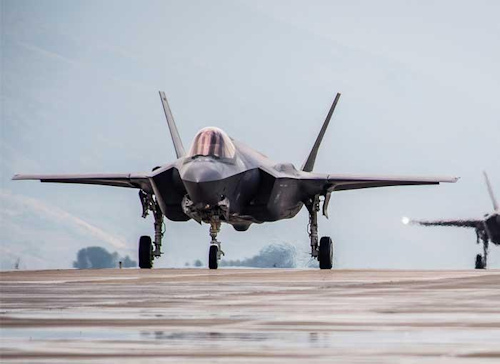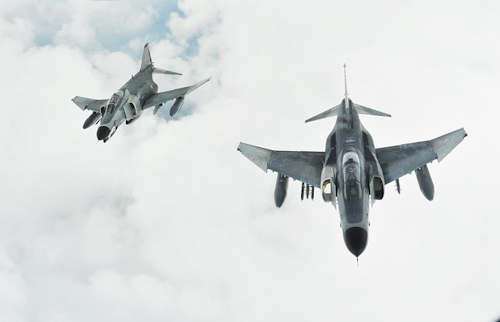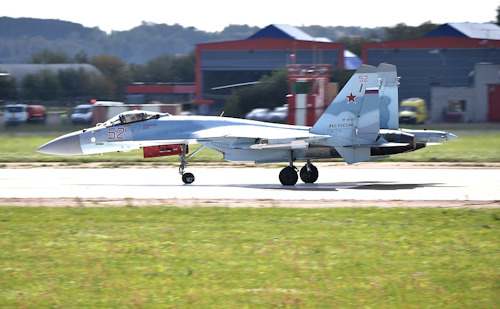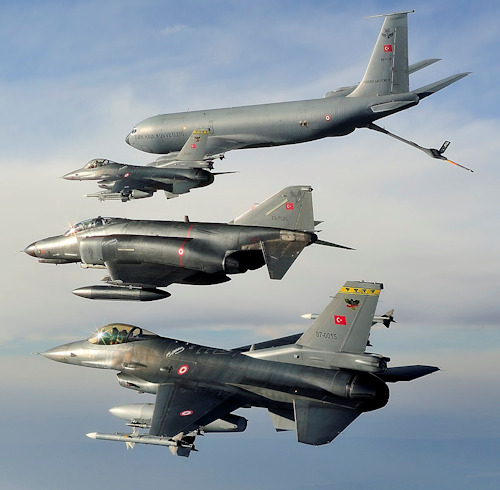The developments of the last weeks concerning the querelle that has been opposing Turkey on one side and the rest of NATO on the other hand for the past two years on the purchase programs of the Russian anti-aircraft missiles S-400 and of the F-35 aircraft have opened wide the doors to a series of scenarios that, before now, seemed unthinkable.
Against the background of the worsening of relations with NATO following the ultranationalist / Islamist authoritarian drift of the Turkish regime's strong man, Recep Tayyip Erdoğan, and of the failed 15-16 July 2016 coup, Turkey had signed 2017 in September , a contract from 2,5 billions of dollars for the supply of an unspecified number of units of anti-aircraft missile systems S-400, by many analysts considered as the best currently in service in the world.
According to information provided by Turkey, the Russian S-400 should form, in conjunction with the Italian-French FSAF / TAFs produced by "Eurosam", the backbone of the anti-aircraft defense of the Turkish armed forces in the coming years. The reason why Ankara aims to deploy two types of relatively similar missiles produced by international actors located on geopolitically antithetical positions is soon to be said: given that not even the most hidden objectives of the "sultan" are to make Turkey the new great power of the central area between Europe, Russia, the Middle East and Africa and that this policy will inevitably lead Turkey to clash even militarily with the major international powers, the FSAF SAMP / T serve Turkey if Ankara were to face an armed conflict with Russia while the S- 400 are equally useful if Ankara were to fight against NATO instead. This is the real Gordian knot of the story!
In retaliation for the bravado shown by the "Turkish Sultan", already in June 2018 and then again in August of the same year, the United States Senate had approved two bills to ban the sale of the Lockheed Martin F-combat aircraft to Turkey. 35 Lightning II; proposals promptly countersigned by President Trump. Despite this, the negotiations continued to proceed feverishly in the shadows but the Turks proved to be substantially unavailable to renounce a weapon system like the S-400 which for them have an absolutely strategic value. Not only that, this year's 18 May, after claiming that Turkey would be willing to buy the famous American Patent MIM-104 missile system, Erdoğan said that his country was in talks with Russia to start the joint production also of the S-500 while the 12 July, the long-awaited deliveries of the S-400 have begun; a free diplomatic slap.

The stars and stripes retaliation came a few days later, the 17 July, when with an executive order (which was somewhat bizarrely motivated) Trump canceled every sale of the F-35 to Turkey, interrupted all the pilots' training activities and Turkish technicians on the aircraft and even excluded all Turkish industries from the component production chain linked to the aforementioned stealth aircraft.
However, the US "military sanctions" against the riotous partner have certainly not been limited to F-35 as most people think! Over the past few months, the United States has set up a whole system of military sanctions designed to degrade Turkey's military capabilities to a minimum and apply pressure to bring Erdoğan to a position of submission and Western allies are already taking the first steps in the direction traced by the White House. These sanctions are at different levels and affect all branches of the armed forces as well as the Turkish military-industrial complex but it is precisely in the "air" sector that they are producing the first dramatic effects.
Before continuing, it is good to remember that, since Turkey is a member of NATO from the 1952, its entire combat line is almost entirely made up of Western, preferably American, means of production. This applies especially when it concerns the first combat line of the aeronautics (Türk Hava Kuvvetleri - THK) which from around 50 years is based on a deadly triad that includes the F-5, the F-4 and the F -16.
Purchased in over 200 specimens belonging to the F-5A / B versions of American production, CF-5A / D of Canadian production and NF-5A / B of Dutch production, the Northrop F-5 Freedom Fighter has been for years the mainstay of both the hunting and tactical support departments of THK, being used in all operations, in peace and in war, which saw the Turkish armed forces as protagonists from the 60 years to today. Currently about 40-50 aircraft are still in service and all have been brought to the F-5 / 2000 standard which has allowed these simple and versatile aircraft to maintain a remarkable war capacity even in the 2000 years.
 Specimens of American and German origin belonging to the F-1974E and RF-233E versions, the McDonnell Douglas F-4, entered service from 4 in 4 Phantom II is the first and still the only example of heavy and multi-role hunting in service at THK. Arrived too late to be able to participate in the 1974 conflict in Cyprus, the "Phantom" was nevertheless widely used during the interminable conflict against the Kurds in the south-east of the country and, in recent years, was even used during the Turkish offensive episodes in Iraqi and Syrian lands against the PKK sanctuaries, the Syrian Kurds and the ISIS as well as in the incessant provocation operations against Greece in the Aegean. After the retirement, in the 2015, of the last RF-4E and the previous withdrawal of the most worn F-4E, the last exemplary 54 of F-4 still in service all belong to the exceptional version F-4E 2020 Terminator, jointly modernized by Turkey , The United States and Israel on the model of the Kurnass 2000 (the Israeli F-4E previously augmented by Israel Aerospace Industries - IAI) and that according to the majority of analysts the final epitome of the successful formula of the St Louis two-seater.
Specimens of American and German origin belonging to the F-1974E and RF-233E versions, the McDonnell Douglas F-4, entered service from 4 in 4 Phantom II is the first and still the only example of heavy and multi-role hunting in service at THK. Arrived too late to be able to participate in the 1974 conflict in Cyprus, the "Phantom" was nevertheless widely used during the interminable conflict against the Kurds in the south-east of the country and, in recent years, was even used during the Turkish offensive episodes in Iraqi and Syrian lands against the PKK sanctuaries, the Syrian Kurds and the ISIS as well as in the incessant provocation operations against Greece in the Aegean. After the retirement, in the 2015, of the last RF-4E and the previous withdrawal of the most worn F-4E, the last exemplary 54 of F-4 still in service all belong to the exceptional version F-4E 2020 Terminator, jointly modernized by Turkey , The United States and Israel on the model of the Kurnass 2000 (the Israeli F-4E previously augmented by Israel Aerospace Industries - IAI) and that according to the majority of analysts the final epitome of the successful formula of the St Louis two-seater.
The General Dynamics F-16 closes the deployment Fighting Falcon, purchased from the United States or produced under license in Turkey by Turkish Aerospace Industries - TAI in 270 units belonging to the F-16C / D Block 30 / 40 / 50 / 50 + versions and today reduced to 245 machines due to operational and inevitable "friction". Turkey has intensively used its F-16 in the Balkans during its participation in the Bosnian and Kosovo wars, in operations against the PKK Kurds, in Iraq and in Syria against the PKK, the Syrian Kurds and the ISIS and in the various provocations on the border with Greece. To ensure that they maintain their operational capacity despite the passing of the years, Turkey has signed a contract worth 1,1 billion dollars under which the TAI should modernize 165 aircraft to bring them to the standard F-16 Block 50 + as they can so continue to work alongside the F-35 and the future TAI TF-X whose mock-up was presented at the Le Bourget Paris aeronautical show not long ago.
 In any case, after the latest developments it is now very likely that all these projects will remain so! In fact, a detail that the mass media have "forgotten" to report is that, based on the "soft military sanctions" approved by the White House, the United States has already stopped any cooperation with Turkey regarding the maintenance of F-16 weapon, avionics and radar systems while from 2020 onwards to Lockheed Martin and other American companies it will be legally forbidden to supply any type of spare parts for THK jets.
In any case, after the latest developments it is now very likely that all these projects will remain so! In fact, a detail that the mass media have "forgotten" to report is that, based on the "soft military sanctions" approved by the White House, the United States has already stopped any cooperation with Turkey regarding the maintenance of F-16 weapon, avionics and radar systems while from 2020 onwards to Lockheed Martin and other American companies it will be legally forbidden to supply any type of spare parts for THK jets.
As a buffer solution, the Turkish authorities have begun to enter into negotiations to obtain spare parts from third parties, including the Korean Aerospace Industries - KAI responsible for maintaining the South Korean F-16 fleet, but this is of a "buffer solution". Already today the maintenance of the operational capabilities of the Turkish air forces is guaranteed by the conspicuous presence of Pakistani pilots and mechanics due to the purges that have reduced the ranks in the aftermath of the failed coup of the 2016. Considering now also the aggravating circumstance of the block of spare parts, it is estimated that by the end of the year only half of the F-16 will be "Fully Mission Capable - FMC" also already now the TAI, the ASELSAN and the other industries of the Turkish defense reported the extreme difficulty in carrying out aircraft maintenance and modernization contracts as a result of the interruption of the supply chain. It is therefore possible that the modernization plans will suffer significant delays, when there are no actual cancellations.
According to some estimates, in the case of a total blockade by Western "partners", the Turkish air force could survive for two decades through the progressive cannibalization of part of the fleet to support the remainder but even this would only be a slow agony.
 A revealing example of what can happen is seen by looking at the sudden stop in the production of the TAI / AgustaWestland T129 ATAK attack helicopter. Developed jointly by TAI and AgustaWestland starting from the Agusta A129 Mongoose Italian, T129 ATAK was ordered by Turkey in 77 specimens for its own armed forces (59 for the army and 18 for the gendarmerie) and subsequently offered on the international market immediately finding the interest of countries like Azerbaijan, Bahrain , Jordan, Malaysia, Poland, the Gambia, the United Arab Emirates, Saudi Arabia, the Philippines, South Korea, Libya, Morocco, Brazil and Pakistan. The latter had applied for the first foreign customer by signing a contract for the supply of 30 machines. Yet after Rolls Royce announced the halt to the delivery of the LHTEC CTS800-4A engines, TAI had to stop production after 41 helicopters were handed over to the army and 6 to the gendarmerie. It is not clear at this point if Pakistan will ever see the helicopters for which it has paid or if the Turkish army and gendarmerie will receive the remaining aircraft they have ordered. If this is then counted the exclusion from the F-35 program and the probable early end of the TAI TF-X project, since it requires the decisive contribution of BAE Systems to reach the operational stage and the probable interruption of all the other contracts in the aeronautical field with the western partners for a total value of 45 billion dollars, we can well understand how the scenario that promises for Turkey's blue weapon is really nightmare.
A revealing example of what can happen is seen by looking at the sudden stop in the production of the TAI / AgustaWestland T129 ATAK attack helicopter. Developed jointly by TAI and AgustaWestland starting from the Agusta A129 Mongoose Italian, T129 ATAK was ordered by Turkey in 77 specimens for its own armed forces (59 for the army and 18 for the gendarmerie) and subsequently offered on the international market immediately finding the interest of countries like Azerbaijan, Bahrain , Jordan, Malaysia, Poland, the Gambia, the United Arab Emirates, Saudi Arabia, the Philippines, South Korea, Libya, Morocco, Brazil and Pakistan. The latter had applied for the first foreign customer by signing a contract for the supply of 30 machines. Yet after Rolls Royce announced the halt to the delivery of the LHTEC CTS800-4A engines, TAI had to stop production after 41 helicopters were handed over to the army and 6 to the gendarmerie. It is not clear at this point if Pakistan will ever see the helicopters for which it has paid or if the Turkish army and gendarmerie will receive the remaining aircraft they have ordered. If this is then counted the exclusion from the F-35 program and the probable early end of the TAI TF-X project, since it requires the decisive contribution of BAE Systems to reach the operational stage and the probable interruption of all the other contracts in the aeronautical field with the western partners for a total value of 45 billion dollars, we can well understand how the scenario that promises for Turkey's blue weapon is really nightmare.
At this point, the last natural question is: what solutions can Ankara's political and military decision-makers envisage?
Although the "military sanctions" have been put in place in order to bend Erdoğan and, thanks to the economic crisis in Turkey, bring him back to a position of submission, the author of the present analysis believes that this scenario is almost nil. Having constantly monitored the situation and internal involution of Turkey from the 2004 to the present day and having given me a fairly realistic picture of Erdoğan's mindset, of his long-term geopolitical goals and, above all, of what the Turks in general expect from him (read: the complete rebuilding of Turkey as the new empire declared heir of the Ottoman one), I believe that the scenario of a capitulating Turkey reduced again to the status of "CIA colony" exists only in the wild mental fantasies of some analyst of Washington and his family minions our own.
 Turkey is now an autocephalous entity that, if it realizes that it is no longer able to achieve its goals by staying in NATO, would cut the bridges behind it without thinking twice. If Erdoğan has not yet made this move it is only because he expects (it goes) to still get something from his relations with NATO and the EU (read: the F-35 and many other weapons and investments). Now, however, that Trump has framed him, the Turkish sultan remains only the road of the "great somersault", the same one that all the Eastern European countries already members of the Warsaw Pact have already done over the years' 90 and 00, only this one turn the other way around: focus on Russia. In this regard, Putin has already sensed the possibility of capitalizing on success by offering Turkey the possibility of buying and even producing under license the Mikoyan Mig-35 Fulcrum-F, the Sukhoi Su-35 Flanker-E and the Sukhoi Su-57.
Turkey is now an autocephalous entity that, if it realizes that it is no longer able to achieve its goals by staying in NATO, would cut the bridges behind it without thinking twice. If Erdoğan has not yet made this move it is only because he expects (it goes) to still get something from his relations with NATO and the EU (read: the F-35 and many other weapons and investments). Now, however, that Trump has framed him, the Turkish sultan remains only the road of the "great somersault", the same one that all the Eastern European countries already members of the Warsaw Pact have already done over the years' 90 and 00, only this one turn the other way around: focus on Russia. In this regard, Putin has already sensed the possibility of capitalizing on success by offering Turkey the possibility of buying and even producing under license the Mikoyan Mig-35 Fulcrum-F, the Sukhoi Su-35 Flanker-E and the Sukhoi Su-57.
Not only that, if Turkey were still determined to complete the TAI TF-X project for reasons of both utility and prestige, then the Russian comrades such as Rostec and United Engine Corporation could take over from BAE Systems and implement those technological transfers necessary to Ankara to carry out this delicate project.
At this point, however, what to do with the impressive fleet of today's high-performance combat aircraft, a legacy of decades of Turkish militancy in the Atlantic Alliance and which now risks becoming a burden rather than a resource?
A possible answer is the gradual sale of aircraft, disused cells, spare parts, equipment and various other machinery to Iran and Pakistan aeronautics in order to obtain the necessary funds to start the complete conversion of THK to the original equipment Russian.
 If this hypothesis may seem bizarre at first glance it would be enough to remember that the Pakistani Air Force has experience of operations with F-16 for almost 40 years while the Iranian Air Force operates with the F-5 and the F-4 from even more time. If Turkey then opted to sell its 245 F-16C / D Block 30 / 40 / 50 / 50 + to Pakistan and its 54 F-4E 2020 Terminator and 40-50 F-5 / 2000 plus an unknown number of cells previously disposed of by Iran, then it could gain enormous political credit in these two countries, often already courted in various ways by the "sultan" and at the same time literally beat cash to be reinvested in the re-equipping of its aeronautics with aircraft of Russian production.
If this hypothesis may seem bizarre at first glance it would be enough to remember that the Pakistani Air Force has experience of operations with F-16 for almost 40 years while the Iranian Air Force operates with the F-5 and the F-4 from even more time. If Turkey then opted to sell its 245 F-16C / D Block 30 / 40 / 50 / 50 + to Pakistan and its 54 F-4E 2020 Terminator and 40-50 F-5 / 2000 plus an unknown number of cells previously disposed of by Iran, then it could gain enormous political credit in these two countries, often already courted in various ways by the "sultan" and at the same time literally beat cash to be reinvested in the re-equipping of its aeronautics with aircraft of Russian production.
At the same time, this scenario would translate into a situation of absolute victory even for Pakistanis and Iranians who would have a golden opportunity to greatly strengthen the backbone of their respective aeronautics, both hungry for aircraft for different reasons.
Needless to say, such a move would immediately attract retaliation of some kind from Western chancelleries but you can bet that the vainglorious Turkish president would indeed exploit the situation to mobilize the people under the banner of nationalism and launch messages of mobilization towards the disinherited Muslim masses who increasingly see him as their "champion".
All that remains is to wait and see what the next move of this nerve-racking "chess game" will be.
Photo: Kremlin / US Air Force / Türk Silahlı Kuvvetleri












